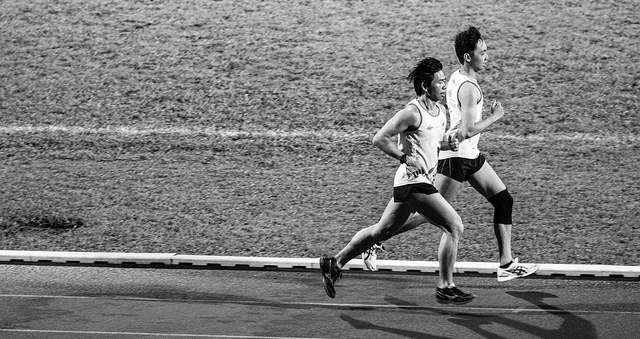Racing a 5k requires a smart combination of speed, endurance, and race specificity. Here’s how to train for a 5k and set a new personal best (PB).

The 5k distance used to be a long race for me. During high school cross country, I would tell myself “You’re in this for the long haul so stay tough.”
But then in college, cross country became 8k and during the spring season there was a 10k on the track (yes, that’s 25 mind-numbing laps!). After college I ran my first ten-mile race… then a half-marathon… then a marathon.
After a while, a measly 3.1 miles doesn’t seem very far.
And it’s not – most of us can run a 5k in 30 minutes or less. If you’re slower, your rate of improvement is going to be dramatic if you train smart. So hang in there – you’ll be much faster very soon!
It doesn’t matter if you’ve run a this distance in 20 minutes or 35 minutes; the principles that illustrate how to train for a 5k are the same.
How to Train for a 5k

Over the years of coaching hundreds of athletes to new personal bests from 1.5 mile military fitness tests up to the 50-mile ultramarathon distance, I’ve been given a “private look” inside how runners approach their training.
And most of the time, I’m horrified! There’s no progression. They avoid race-specific workouts. I see pacing mistake after pacing mistake.
If you want to run faster you need to take the next logical step in how you prepare and plan your training schedule. Even though you might think the 5k is short, it demands very specific workouts.
Good 5k training includes three distinct aspects of running fitness: speed, endurance, and race-specific fitness. Avoid fast-paced training runs and you won’t have that “higher gear” to hammer the last mile. Overlook the endurance portion and the distance will feel very long. Skip the specific 5k workouts and you’ll feel flat with no power.
Balancing all three ensures that you’ll feel powerful on race day and accomplish your race goals. So if you’re wondering how to train for a 5k, here’s how to execute each one (no matter what fitness level you’re at right now).
1. Get FAST
Have you ever watched a little kid play outside? They sprint everywhere. They don’t think about how to strike the ground with their foot, run tall, or stay relaxed – they just do it.
Watching a bunch of grade schoolers sprint around a playground can be instructive for all of us because as we get older, we inevitably lose the ability to run really fast.
It’s time to reclaim that skill.
There are two effective ways of developing speed that are appropriate for most of us (there are actually countless ways of formulating sprint workouts, but let’s stick to what works for 98% of runners).
Get Faster with Strides
First, there are strides. Strides are about 100 meter accelerations. You start at an easy jog, build to about 95% of your max speed and then slow to a complete stop. Each stride should take about 20-30 seconds.
Strides can be done 2-3 days per week after an easy run – for more, read my full article on how to run strides.
We also have a video from Strength Running’s YouTube channel:
These are a fundamental drill to complete on a nearly weekly basis. Don’t skip your strides!
Run Even Faster with Hill Sprints
Once you’re comfortable running strides, you can progress to a more advanced type of speed training: hill sprints. These are 8-12 second maximum effort sprints up a steep hill with a full walking recovery in between.
Hill sprints are more advanced and should only be done by runners who are comfortable with running fast. But once you start them, they can help you build injury resistance, improve your neuromuscular control, and develop the ability to run at top speed.
Follow these principles when adding hill sprints to your training plan:
- Run your first hill sprint of every session at a sub-maximal effort. Think of it like a warm-up.
- Take at least a minute to walk down the hill, catch your breath, and ready yourself for the next sprint. You discount the benefits of hill sprints if you rush your recovery.
- Start with eight second hill sprints and only three repetitions. Build to 6-10 reps of 10-12 seconds over 3-5 weeks.
- Run hill sprints after an easy run 1-2 times per week.
It’s true that when you first start running hill sprints, there’s an inherent injury risk, so play it safe at first. You are running up a steep hill as fast as you can, after all. But after 2-3 sessions, they become protective from injury and help you gain tremendous strength and speed.
They’re a staple in the training plans included in Brad Hudson’s book Run Faster and I do them myself – they’re incredibly effective.
Plus, they’re a helluva lot of fun!
2. Develop Your Endurance

Every race demands a certain level of endurance – the 5k is no different. After all, if you can’t run 3.1 miles comfortably during training then how can you race the same distance fast?
It’s always better to be over-prepared so that’s why you run a consistent long run. For most runners, that should be in the 7-10 mile range depending on your ability. More competitive runners will want to do a significantly longer run. It all comes down to efficiency, which is gained through long training runs.
And if you want to get really jacked up, you’ll do some fast running during your long run!
But is the long run the only way to build endurance? No way. It’s just one piece of the puzzle.
Consistency in Higher Weekly Mileage
There are two others: weekly mileage and general consistency (which we know is the secret sauce of good training since I focused an entire year on building consistency).
Your weekly mileage (or volume) is simply the number of miles you run every week. The more you run, the more endurance you’ll gain. I’m over-simplifying here, but most runners need to run more. Even a modest increase of 20% in mileage can produce big gains in fitness that will help you run faster.
So let’s say you’re running 25 miles per week and you increase that to 30 miles every week. That’s a 20% increase – not bad!
But what if you ran that extra 5 miles for 15 weeks straight? That’s an extra 75 miles – or three full weeks of training – condensed into the same training period. The power of consistency is that modest increases in mileage build over time and contribute to your fitness gradually. Like compound interest, the cumulative impact over time is powerful.
An extra mile or two added to your long run and a few more on your weekly schedule might not seem very difficult (and it’s usually not if you’re honest with yourself), but over time they dramatically improve your endurance.
That’s how you make a fast pace seem comfortable. And last year’s PR pace becomes this year’s easy pace.
You can read more free advice on how to set your next personal best!
3. Race Specificity: 5k Training at its Best
Here is where we combine your speed with your endurance.
Both of those skills (Yes, speed and endurance are learned skills! Click here to tweet that!) help build your race specific fitness.
So what exactly is race specific fitness? Simple: the type of fitness you need to run your goal pace for an entire 5k.
If your 5k goal pace is 8:00 per mile, then your race specific fitness is the ability to hold that pace for 3.1 miles.
Getting in shape to do that requires a blend of speed and endurance. Both of those skills are more general, though. The specific nature of your race is what requires smarter workouts.
If you’re training for a 5k and get a custom training plan, you’ll see the exact progression of workouts that transition from general to specific. It’s always critical to recognize that any workout by itself means very little. It must come from another workout – and lead to another.
But just to show you what a 5k-specific workout looks like, here’s an example:

Or, it would be written like this: 6×800 @ 5k Goal Pace with 400m recovery.
You’ll see here that the total distance of interval running adds up to 3 miles and it’s done exactly at your goal pace. Just like the race!
Depending on your ability and fitness level, you can modify the number of repetitions, interval distance, and recovery running to make this slightly easier or more difficult.
It doesn’t matter if you’re a 33 minute 5k runner or a 20 minute 5k runner – these principles are universal and can help all of us learn how to train for a 5k – and set new personal bests.
How Many Weeks to Train for a 5k?
The total duration of your training plan will vary depending on your starting fitness, weekly mileage, and goal race. Some people have a strong foundation and can run a 5k race any given weekend.
But in order to progress, avoid injuries, and focus on attaining a new Personal Best, allow at least 10-12 weeks to specifically train for a 5k prior to the race.
Want more advice on how to train for a fast 5k? Get our free book The Strength Running PR Guide!